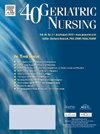Development and external validation of risk prediction models for depression in patients with osteoporosis
IF 2.4
3区 医学
Q3 GERIATRICS & GERONTOLOGY
引用次数: 0
Abstract
Purpose
Patients with osteoporosis have a significantly increased risk of depression compared with those without osteoporosis. The aim of this study was to develop and validate predictive models of depression risk for the osteoporosis population.
Methods
Data from the National Health and Nutrition Examination Survey (NHANES) 2005–2010, 2013–2014, and 2017–2018 were used in this study. Data from the 2017–2018 survey cycle was used as the external validation set. For the remaining years of data, 70 % of the subjects were randomly assigned to the training set and the remaining subjects formed the testing set. Based on literature reference, variables were collected and SVM-RFE algorithms were used for feature selection to screen predictor variables. The prediction model was constructed via multivariate logistic regression; the nomogram was established based on the results. The model performance was evaluated using the area under the receiver operating characteristic curve (AUC), calibration, and decision curve analysis (DCA).
Results
Sleep disorder, education, HDL-C, 25-hydroxyvitamin D, BMI, age, triglycerides, Bilirubin, smoke, C-reactive protein, gamma glutamyl transferase, alkaline phosphatase, diabetes mellitus and HbA1c were included in the nomogram after filtering predictive variables. The AUCs of the nomogram for the training set, testing set and external validation set were 0.831 (95 % confidence intervals (CI) = 0.784–0.878), 0.710 (95 % CI = 0.623–0.796), and 0.714 (95 % CI = 0.623–0.804), respectively. The brier scores in the training set, testing set and external validation dataset were 0.080, 0.101, and 0.114 respectively. DCA revealed that the nomogram model in the training, testing set, and external validation set had a net benefit when the risk thresholds were 0–0.38, 0–0.20, and 0–0.22 respectively.
Conclusions
We have developed a depression risk prediction model for clinical application in patients with osteoporosis, which aids in identifying individuals at an early stage who are at risk of developing depression.
骨质疏松症患者抑郁风险预测模型的建立和外部验证
目的:骨质疏松症患者患抑郁症的风险明显高于非骨质疏松症患者。本研究的目的是开发和验证骨质疏松症人群抑郁风险的预测模型。方法采用2005-2010年、2013-2014年和2017-2018年美国国家健康与营养检查调查(NHANES)的数据。使用2017-2018年调查周期的数据作为外部验证集。对于剩余年份的数据,70%的受试者被随机分配到训练集,其余受试者组成测试集。在文献参考的基础上,收集变量,利用SVM-RFE算法进行特征选择,筛选预测变量。通过多元logistic回归构建预测模型;根据实验结果建立了模态图。使用受试者工作特征曲线下面积(AUC)、校准和决策曲线分析(DCA)来评估模型的性能。结果睡眠障碍、受教育程度、HDL-C、25-羟基维生素D、BMI、年龄、甘油三酯、胆红素、吸烟、c反应蛋白、谷氨酰基转移酶、碱性磷酸酶、糖尿病、糖化血红蛋白过滤预测变量后均被纳入nomogram。训练集、测试集和外部验证集的nomogram auc分别为0.831(95%置信区间(CI) = 0.784 ~ 0.878)、0.710 (95% CI = 0.623 ~ 0.796)和0.714 (95% CI = 0.623 ~ 0.804)。训练集、测试集和外部验证数据集的brier得分分别为0.080、0.101和0.114。DCA结果显示,当风险阈值分别为0-0.38、0-0.20和0-0.22时,训练集、测试集和外部验证集的nomogram model具有净收益。结论建立了一种可用于骨质疏松症患者抑郁风险预测模型,该模型有助于早期识别有抑郁风险的个体。
本文章由计算机程序翻译,如有差异,请以英文原文为准。
求助全文
约1分钟内获得全文
求助全文
来源期刊

Geriatric Nursing
医学-护理
CiteScore
3.80
自引率
7.40%
发文量
257
审稿时长
>12 weeks
期刊介绍:
Geriatric Nursing is a comprehensive source for clinical information and management advice relating to the care of older adults. The journal''s peer-reviewed articles report the latest developments in the management of acute and chronic disorders and provide practical advice on care of older adults across the long term continuum. Geriatric Nursing addresses current issues related to drugs, advance directives, staff development and management, legal issues, client and caregiver education, infection control, and other topics. The journal is written specifically for nurses and nurse practitioners who work with older adults in any care setting.
 求助内容:
求助内容: 应助结果提醒方式:
应助结果提醒方式:


